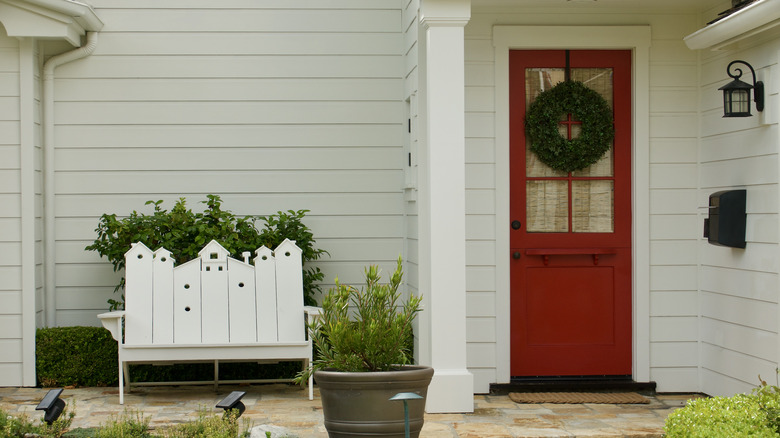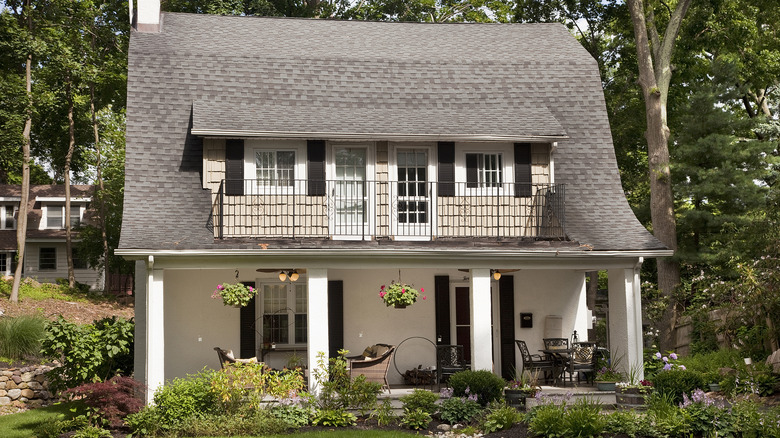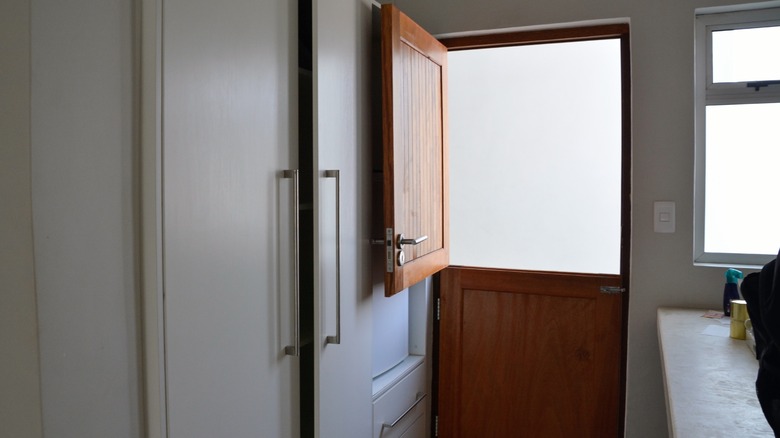If You Spot A Home With A Split Front Door, This Is What It Means
Are you having trouble keeping pesky livestock with muddy hooves and shedding fur out of the house? Early Dutch settlers to America had an answer you can still see on historic homes — and even some modern ones — today: Dutch doors. This type of door splits horizontally, meaning you could open the top half to holler, "Dinner's ready," into the front yard while the bottom half keeps the paddock puppies and quack packs outside where they belong. Of course, today, this isn't a problem for too many of us — homesteaders and farm animal sanctuary managers aside. Dutch doors remain popular because of their practical uses, which extend far beyond the agricultural and growing aesthetic appeal.
When Dutch colonists settled along the Hudson River in what is today New York State in the 1600s, they brought building and architectural traditions from Europe with them. One of these traditions was the split, double-hung, or half door, a style that came to be known as the "Dutch door" after they popularized it in these new-to-the-settlers lands. The doors, originally barn rather than house entranceways in their native Europe, can be seen on Dutch Colonial homes across New York State and into Delaware, New Jersey, and Connecticut.
Why were split front doors so popular?
Dutch doors are essentially standard house doors cut in half. Each half, top and bottom, features two hinges and a bolt and moves independently. Only the bottom half has a lockable doorknob and, occasionally, a sill; sometimes, the top half features a non-opening window. Most Dutch door halves can be locked together, functioning as a whole door if required. Single Dutch doors are the most common configuration, but there are also double Dutch doors, where, as the name implies, two Dutch doors stand side by side. In this case, each split door can be used independently or latched together and opened like a single, albeit enormous, door. They're used as back and front entrances and sometimes inside a home.
At the time, it wasn't as if Dutch doors were the only types of doors to choose from, so what about these farmyard hand-me-downs made them so favorable? Perhaps the most obvious benefit was that you could open the top door to let fresh air circulate through a home on a hot day while keeping rambunctious kids safely inside and, as we already mentioned, unwanted critters — whether that be produce-stealing rats or poop-dropping chickens — out. Moreover, it provided a safe way to engage with visitors who came to your door who weren't friends or family: think delivery staff, salespeople, or even customers. Letting more light into the home on dark winter days was another benefit.
Dutch door uses in the modern home
Despite these clever functions, Dutch doors fell out of favor in the 19th century due to the growing popularity of Georgian architectural traditions and the invention of the screen door. Thankfully, many original doors have been preserved on private and public historic homes, particularly in New York State. The 1663 Stone House, part of the Bronck House and Barns in Coxsackie, features Dutch doors with original fixtures. Bevier-Elting House, which is believed to be the oldest surviving house on Historic Huguenot Street in New Paltz, has a Dutch door as its front door. Philipse Manor Hall has five Dutch doors (four in use and one retired) — the front door features an original fanlight window. Other historic houses in New York State with Dutch doors include the Vander Ende-Onderdonk House and Onderdonk House.
Dutch doors often appear in lists of inviting farmhouse front door ideas, not just because they're derived from actual barnyard architecture. Many attributes that led to the popularity of this door style among early settlers in America remain true today: brightening and refreshing a home, greeting visitors safely, and keeping people, pets, or pests outside or in. AIA New York notes Dutch doors proved particularly useful as interior doors in a Pennsylvania dementia care facility, helping staff discreetly check in on residents when they were in their rooms. And, of course, you can't beat the nostalgia and authenticity of a Dutch door, especially for homeowners looking to restore their historic homes in a period-appropriate way or connect with their heritage.


